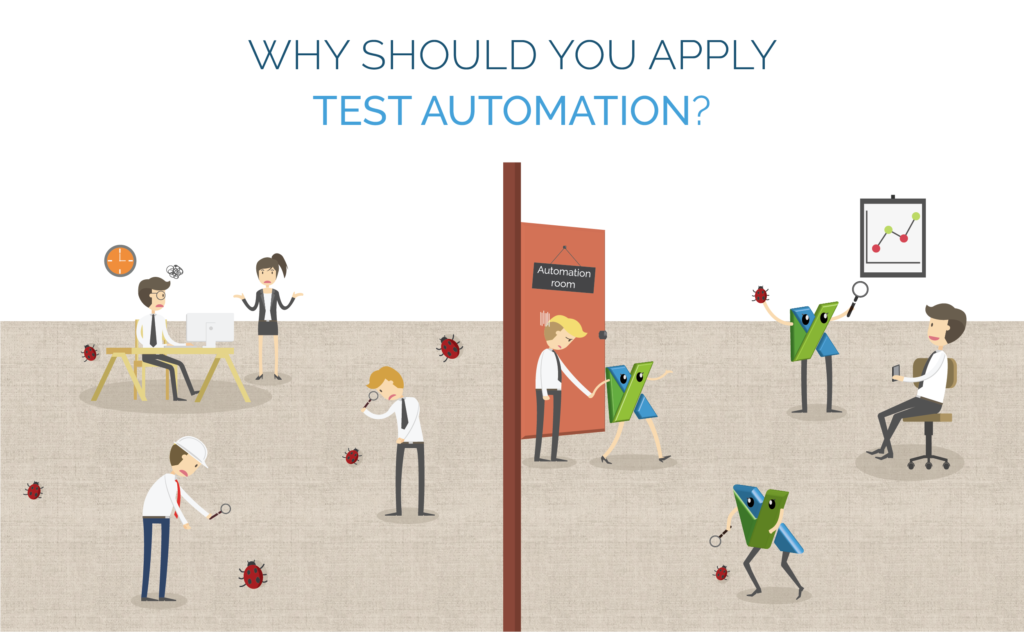The complexity of advanced technologies these days makes it a real challenge to deliver high-quality applications quickly, especially when your products need to go through intensive manual testing in the release process. Taken into account different factors such as multi-platform support, cross-browser, responsive design and more, the manual testing of a website could face unexpected complications and extra effort. More time than not, these impediments prove to be considerable burdens and drag down delivery time as a consequence. So instead should you be thinking about test automation? What are the benefits of test automation for your development process?
Automation testing, while initially seems to take more time, especially during the first few months of developing test scripts, will prove to be a more effective approach in the long run, both in regards of time and resources since by the time the automation solution is completed, it’s a matter of execution and maintenance with limited effort. The benefit is greatly multiplied in the project that requires intensive regression testing. The ability to reuse the test framework later by other teammates is also a big plus. Mature automation solutions typically do not require many staff for daily operations so that could save a bit budget for our project.

One of the key criteria for automation is that certain testing activities would prove to be impractical when carried out by human. Things such as validating the exact size & color of all controls on the application under test, processing a large amount of data or calculating the performance of the website are better executed by machine for consistency purpose. Besides, having such cases automated improves test coverage for many areas across project.
What Kind of Tests Should be Considered for Automation?
Ideally, one would prefer to automate as much test cases as possible to improve test coverage and take advantage of test automation. However, a typical real project will have limited time and resources. In that situation, the following tests should be given higher priority than others:
- Repetitive Tests or regression testing: These are the most common cases for automation. The tests here are usually basic features of the product that need to be checked whenever a new build is available. These tests require much time to execute manually while they are typically easy to automate.
- Detailed GUI Validation: These tests include cases such as checking for the exact size/color of a certain control or comparing two lengthy paragraphs.
- Data Processing and Validation: Data-driven is a common practice in automation testing which helps users to evaluate whether the system processes data correctly or not. The ability to iterate a test multiple times thru a set of data or commit massive data transaction will help testers save a lot of regression time.
- Cross Platforms Tests: Automation projects that cover these kinds of tests will improve test coverage and reduce manual test effort significantly. Automation tools nowadays usually support cross-platform execution where test scripts are written once and can be executed on different platforms later.
- Impractical Manual Tests: These extremely-hard-to-execute test cases are also good candidates for automation. An example would be a test routine where the tester needs to interact with a certain control either in split seconds or after an exact timeout.
The benefit of test automation for these types of testing is greatly affected by which automation tools are used. While test automation often requires investment upfront in terms of time, budget and expertise, some tools require considerably much less than others. For example, Selenium and Katalon Studio are free test automation tools while TestComplete and HP UFT are comprehensive automation solutions but they are very costly. For a more detailed discussion of these tools, refer to A Comparison of Automated Testing Tools.
Benefits of Test Automation
It’s understandable that most of the time, the testing team cannot convert every single case of their manual test into automation. However, an optimal rate as much as 70% test coverage would remarkably improve the general quality of the product.
There are a lot of automation tools that do not require the user to be an expert in order to make use of them. So, next time, when you have a new test project with many test cases that fall into the mentioned situations above, take sometimes to consider an automation plan to make your release cycle faster and boost the overall productivity of the team.
About the Author
Abhishek Kumar, Product Manager
Abhishek Kumar is the Product Manager at KMS Technology. He combines strategic and tactical management expertise with strong qualifications in software development, software testing, test automation, product management, new venture initiation, business development, project management, and general operations. He earned a Master of Computer Applications (Software Engineering) from Guru Gobind Singh Indraprastha University Delhi.
